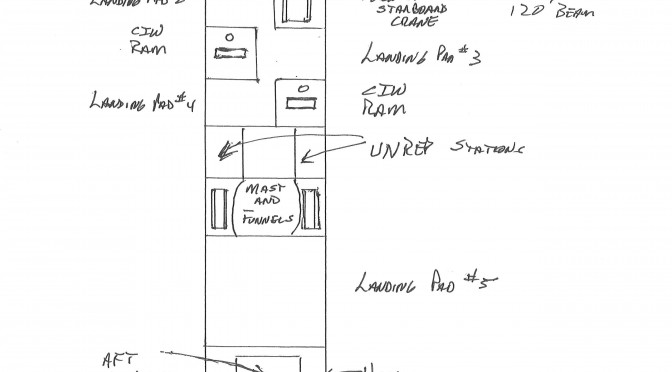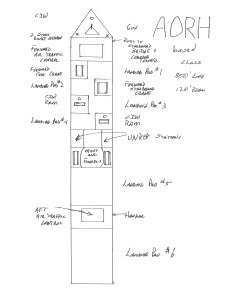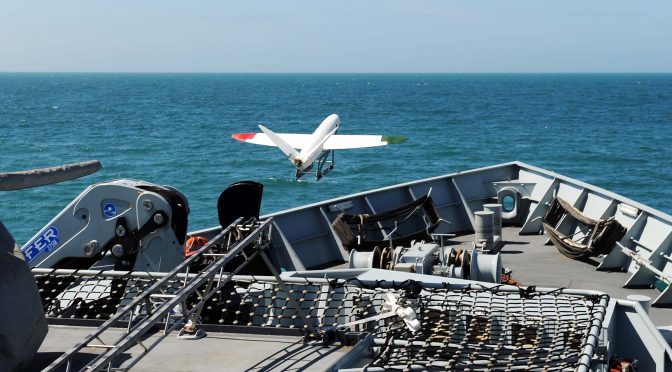Where is the U.S. Navy Going To Put Them All?
Part 3: Two New Ship Classes.
Sketch by Jan Musil. Hand drawn on quarter-inch graph paper. Each square equals twenty by twenty feet.
This article, the third of the series, presents two ship classes that can be used to take to sea the various UAVs, UUVs and buoys suggested in the previous two articles. These ships can provide the space needed to operate, maintain and hangar the equipment as well as house the necessary sailors. Read Part One, Part Two.
The first class, the CVLN (carrier aviation light, nuclear powered), is intended to operate with the two main carrier task forces, providing a home for the many ISR drones, UUVs, UAVs and buoys needed in the increasingly dangerous A2AD environment and to prosecute ASW. The second suggested class, the AORH (auxiliary oiler replenishment helicopter), is intentionally designed to routinely operate far from a CSG, frequently in association with either allied or local navies. The AORH is expressly designed to carry out a wide variety of missions with substantially lower initial construction costs and lower lifetime operating costs.
CVLN class
The intent of the CVLN class is to provide a deep blue sea platform that can operate, in fact come to be seen as needed to operate, with the two primary carrier task forces the U.S. Navy operates. Currently these task forces are almost always on station in the Western Pacific or the Gulf region. Adding a CVLN to the task force provides a home for the ISR drones, so useful in a contested A2AD environment as well as a home for the additional ASW assets the UUVs and Fire Scouts bring to the fleet.
By making the new platform nuclear powered the ship will be able to keep up with the CVNs, in both a strategic as well as a tactical sense. If the President suddenly needs a carrier strike group hundreds or thousands of miles away from their current position, the CVLN will be a fast complement to the CSG. A CVLN that can keep up with the CSGs affords the task force some very useful ASW protection both in transit and upon arrival. In addition, it will provide a permanent arc of ISR drones on the search, locate, transmit and target mission.
As for the tactical use of speed, in naval combat close almost always doesn’t count, and being able to accelerate over a 5-15 minute period at nuclear powered speeds can be just enough to survive an incoming strike. And once more, it allows the CVLN to keep up with the CVNs.
While building a nuclear powered CVLN is of course more expensive initially, once lifetime construction, operating and maintenance costs are considered, it should be notably less costly than an oil powered ship. Installing two of the existing nuclear reactors in use with the new CVNs aboard should provide plenty of power to move 45k tons around effectively and efficiently.
An obvious existing ship class to consider as a starting point for the new CVLN is the existing LHA/LHD design, but tweaked to accommodate nuclear power. If a canted flight deck and catapult were deemed necessary another alternative would be to revisit the old Midway class for design ideas.
CVLN Equipment
So how should the CVLN be equipped? A ski jump or canted flight deck should certainly be considered, although even if the ISR drone is fixed wing it should be small enough to launch off an LHD-style ship. If some of the modified S-3 Vikings or new refueling drones are going to be carried, then the extra expense of a canted flight deck will have to be incurred. Either way, the following, rather basic list of desired equipment should provide the reader with a good idea of what the CVLN will be accomplishing.
The navy should investigate whether it is practical to install one railgun, probably on the fight deck just before the island, aboard a CVLN. Obvious problems to be solved include insuring enough power is available, providing the space for the needed large capacitor just below the railgun and meeting the usual cost-to-benefit analysis applied to any new feature sent to sea.
2 CIWS mounted fore and aft and at least one RAM missile launcher for anti-missile defense are necessities.
15+ ISR drones with traditional jet engines or upgraded Osprey tilt-rotors are needed to execute the search, locate, network and target mission.
4+ UUVs plus the needed docking/launching buoys needed to get them in and out of the water.
15+ Fire Scouts and around 75 ASW oriented TIF Buoys.
4+ Seahawks
1 SAR team with associated equipment.
AORH class
The second suggested choice for the U.S. Navy to add is a ship class based on a modified AOR sized and double hulled design without a full flight deck, approximately 25k tons and oil powered. This class is intended to provide very substantial helicopter and VTOL launching and servicing capabilities, for ASW, amphibious, special-ops or other missions and then executing these missions over the years alongside a large variety of allied nation navies; hence the built in patrol boat capabilities as well as at least one UNREP station port and starboard.
The AORH is a solution to use, at a much lower cost than a CVLN in locations where a carrier task force is not present across the globe, especially in the Arctic, South China Sea, Gulf region and perhaps Northeastern Asia. These are obvious locations to homeport one of each of these ships permanently, but a standard rotation of three ships, perhaps only two ice-strengthened ones are needed for the Arctic, should be built for each requirement.
Reading the list of suggested equipment and capabilities below should provide a good grasp of the variety of missions, and not just ASW or amphibious, this class of ships will be capable of. The abilities this class will provide will substantially augment the small surface force combatants nations in the area already possess.
There has not been a great deal published on what the newly designated Arctic Command is going to deploy. Or do. As far as the U.S. Navy is concerned, my suggestion is to use ice-strengthened versions of what we already have and focus on the only realistic threat, submarines, that the fleet is likely to encounter up there. Let the Air Force provide air cover and if it comes to it, aerial strike capabilities out of Alaska or Greenland. As for ASW or ASuW capabilities, a task force composed of an AORH serving as flagship, 2-3 of the new ASW frigates, a Los Angeles class SSN and a Coast Guard icebreaker on an as needed basis should be ample to meet the nations needs up there.
As for more substantial portions of the fleet, there simply are not enough targets to justify the routine presence of a CCG or DDG. As for an amphibious ship, the American taxpayer as well as our Arctic neighbors should be asking just who we intend to invade up there. There simply is no need for these kinds of assets.
Operating in the Arctic is a new reality that the U.S. Navy has to add to its long list missions to accomplish. But a very limited list of ice-strengthened surface assets concentrating on the ASW mission, a SSN and Air Force provided top cover should handily do the job.
AORH equipment
Once more the following, rather basic list, of desired equipment should provide the reader with a good idea of what the double hulled, AORH should be equipped with.
A gun of some sort and since we have lots of 5-inch guns available one of these will probably be installed. One of the OTO-Melara 76mm family would also function well, possibly even be preferable over the 5-inch gun.
4 CIWS and at least 2 RAM missile launchers, and room for more should be considered if feasible. These are not going to be stealthy ships; they will be sailing in harm’s way, often in littoral waters and WILL be considered high value targets.
4+ ISR drones IF fitted with the new engine upgrade for the Osprey, allowing them to function as a VTOL capable airframe. Without VTOL capabilities the AORH will operate with the ScanEagle like the rest of the fleet.
4+ UUV drones plus the needed docking/launching buoys needed to get them in and out of the water.
15+ Fire Scouts and around 75 ASW oriented TIF Buoys.
4+ Seahawks
Flagship capable in the sense of having both working as well as berthing space aboard for a small task force commander’s team, which will occasionally be multinational.
1 SAR team with associated equipment.
This class will almost certainly be tasked from time to time with hosting Seals and Special Operations teams and their equipment as they come and go on their missions. Ample berthing, operating and maintenance spaces need to be designed into the class. In addition, room for the necessary crane capacity should be available to handle:
2 25’ Mark V.1 Patrol Boats and 2 Mark VI 85’ Patrol Boats
OR
4-6+ Mark V.1 Patrol Boats
The ability to berth and support a company of Marines.
The ability to support the operations of 2-4 of the Marines CH-53E/K helicopters.
Plus the ability to berth and operate on a add something, drop something off basis, whatever additional helicopters or small amphibs the Marine Corp might want to bring aboard.
Summation
The new abilities unmanned flight brings to the fleet are potentially very useful. But as discussed above, achieving the benefits frequently requires the use of the new drones in quantity. The suggested ship classes are two possible ways to get the needed UAVs, UUVs and buoys into the fleet. Another choice is certainly possible though and now is a good time to start discussing the topic.
In the next article we will examine how the Navy can add the railgun to the fleet in quantity and make use of its distinctive qualities in an effective manner. Read Part Four here.
Jan Musil is a Vietnam era Navy veteran, disenchanted ex-corporate middle manager and long time entrepreneur currently working as an author of science fiction novels. He is also a long-standing student of navies in general, post-1930 ship construction thinking, design hopes versus actual results and fleet composition debates of the twentieth century.







